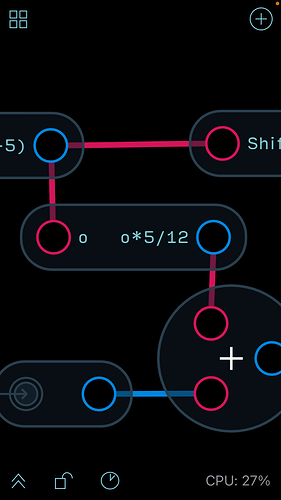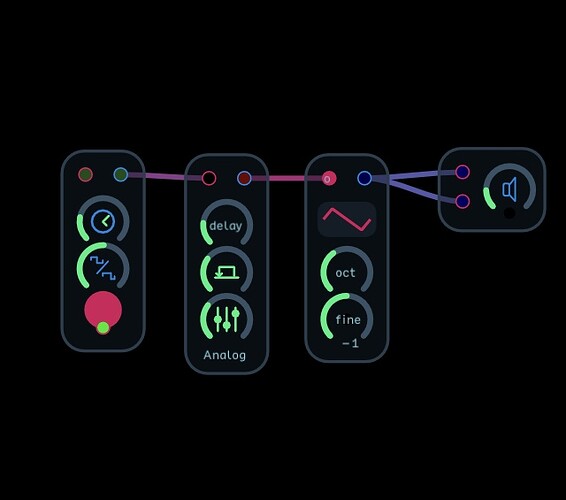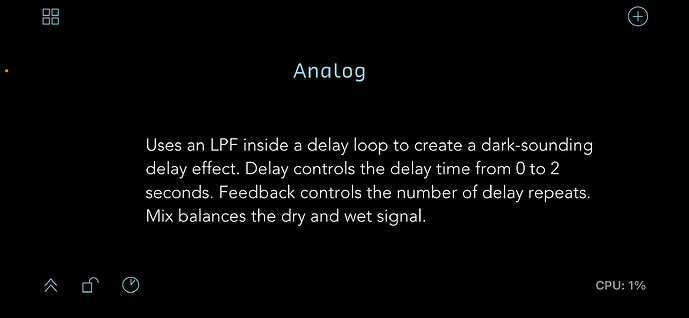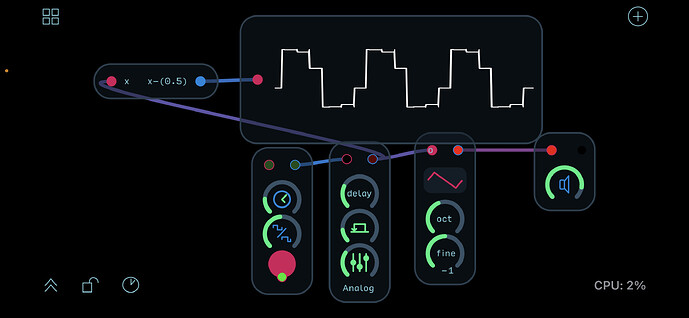Ok – curious, what were doing with all those fifths? 
Sorry man ! I totally oversaw your messages. I got it sorted out by schoen via private ms. My bad. Your formulas really did some great stuff for me too. Let me just try to send you the patch.
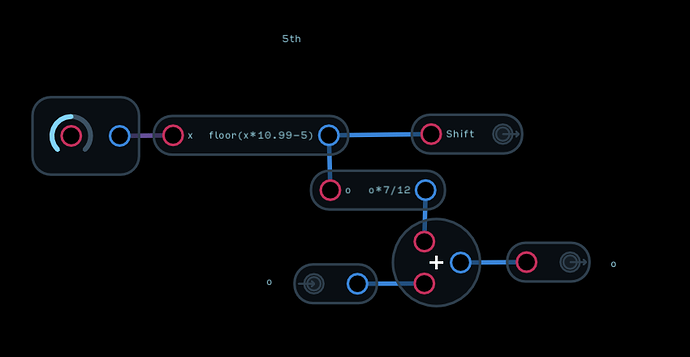
@jersmi here’s the modded oscillator: Fifth V2.audulus (22.3 KB)
It did raise an interesting question. If you shift a pitch up by 7 semitones you’re creating a fifth relative to the original pitch but if you shift down by seven semitones are you shifting down a fifth or a fourth? C shifted up 7 is G which is clearly a fifth but C shifted down 7 is F. The C is a fifth relative to F but the F is a fourth relative to C. Hmmm.
Hi! It is as follows: picture a keyboard. Fifths up from ex C=G,D,A,E,B,F#etc. Down=C:F,Bflst,Eflat,Aflat etc. C to G is a fifth. Its inversion(down) is always a fourth. Same with 2nds, thirds,fourths,fifths,sixths and sevenths. So the inversion of a third is a sixth an reverse. Did that help?
Another thing occured. I entered the expression 2*(o)*RefHz in the Hz patch and before that 5/12 in the octave shift patch. It gives the following: a root(300hz) a fifth, a fourth and finally a major third on top! What is that? Well, sounds great. I think this is really interesting. Turning the ‘fifths’ knob below a certain point it gets inaudible. (Probably have to set max/min value). But, is this not a great thing people would like to explore? Set an lfo to it and you’ll have an arpegiated major triad. Let me hear about it!
Ah, very cool: Circle of Fifths. @Stanley, sounds like you are getting a fresh view using some ideas that are actually quite ancient – I love that!
Now enter different temperaments.
Yep! What about major/minor triads?
I like your circle thoughts!

Actually, this one really speaks to me – John Coltrane’s diagram. You are in very interesting territory!
So circle of fifths when ascending, circle of fourths when descending. In the posted setup, @stschoen, calling it fifths of course means always considering the lower of the two notes as root. But without musical context we probably perceive the interval more in relation to time, simply based on what comes after what, which changes your knob to something like:
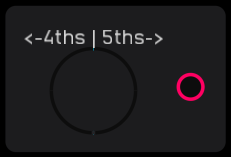
That “reference hz” is shifty here!
Ok nice! Thanks for that. How about thirds? And in such an order: major-minor…?
The refHz in the exp2(o)*refHz expression in the converter sets the zero point for the one per octave scale. In the modular world, pitch is most often represented by a one volt per octave scale. Unfortunately there is no “standard” for which frequenoy 0 volts represents and it varies from manufacturer to manufacturer. Typically it’s C1 or C2. Because most modular oscillators have a wide tuning range this is not generally an issue in practice. When @BiminiRoad proposed using a similar scale in Audulus, we needed to choose a zero value for the scale. The choice of A 440 was somewhat arbitrary and there have been discussions around changing it to something else but this would inevitably break some existing patches. It doesn’t really matter what value you use as far as the relative interval between notes is concerned. Altering the expression in other ways will change the mapping between the value of “o” and the output frequency. In particular 2+(o)*refHz is no longer exponential so there will be a linear relationship between the value of o and the resulting frequency. A value of 0 for o will result in a frequency of 2 Hz and value of 1 will produce 442 Hz assuming that refHz = 440. Kind of leads into the subject of alternate tunings, microtonal scales etc. I made some quantizers early on that allowed you to define you own scale values but I must admit that I still find the well-tempered western scale to be the most pleasing for me. This was one for microtonal scales: Microtonal Quantizer
I’m familiar with the circle of fifths (fourths also if you like), I just found it interesting that the relationship between two notes is labeled differently depending on whether you move up or down. I had never really looked at it in quite that light. I guess I always think in the positive direction lol.
Cool! Thanks. Learning more now.
I made some quantizers early on that allowed you to define you own scale values but I must admit that I still find the well-tempered western scale to be the most pleasing for me.
Me, too, mostly. Culturally conditioned as it were. Though I have explored alt. tunings a lot on guitar (main instrument for me), extended from rock to int’l folk forms in general.
This was one for microtonal scales: Microtonal Quantizer
Thanks for sharing this.
I guess I always think in the positive direction lol.
Lol. Yeah, I was kinda sorting it out in real time there. I like the art-thought that time influences perception.
So, I’m getting to know everything better and better and also starting to make maybe unexpected connections. But, what is this? (See photo). What kind of sorcery is at work here? I cannot fully find a logical explanation yet. The melodic pattern is a very logical one! Is it pre-scripted? But I like what it’s doing. Try it, listen and let me know what you think.
What you have found is like the discoveries of the musical explorers of many years ago that found frequency mathematics determines ratios that are harmonically pleasing to the ear vs. dissonant.
What you are hearing is the math of what happens when the perfect 0-1 square wave of a clock signal is processed through the library analog delay module. This is what it is actually doing:
As a result of the clock signal passing through the delay loop, being subjected to filter and feedback, creates steps, as you see in the third image. I hope this makes sense.
It is much easier to figure out what happens, if you analyze the signal on a scope node. If the signal is audio, then just divide the signal by two until you get something intelligible in the display. Hopefully I have answered your questions, rather than create more!
Thanks! Yes, this makes sense now. Really surprised though. I guess this is one of the results you only get in modular synthesis. Thanks.
I’m happy to be able to help. I just read my reply above, and I hope I don’t seem grumpy or annoyed; that was actually a really neat discovery that likely only results from experimentation, like what you are doing. I just lost a close friend of 18 years to this pandemic on Sunday. My mind has been a bit hazy since then, like I’m trying to be me, but autopiloting through situations, and not doing it so well. I apologize if I came across as something other than friendly. 
I am very sorry for your loss. Don’t worry at all about your reply! It was just fine and nothing about it struck me as off. Wish you get on going well. No appologies needed and don’t be hard on yourself. Grief is a hard and serious thing that has a big impact on one’s live. Best of luck and thank you so much.

